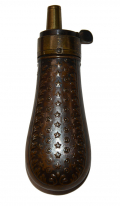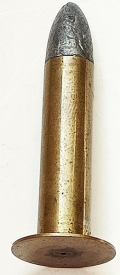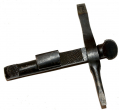site search
online catalog
Firearms
Showing 101 to 120 out of 272
CIVIL WAR SMITH CAVALRY CARBINE #5941
This Smith carbine, complete and all original, rates very good or near fine for overall condition with lots of original finish, good markings, strong color to the metal and wood showing a little… (172-6029). Learn More »
JAMES DIXON & SONS STARS AND DOTS SMALL SIZE POWDER FLASK
With a body measuring just three inches, this bag-shaped flask is the smallest of six variations on the pattern recorded by Riling as made by James Dixon and Sons of Sheffield. This would be correct… (490-6976). Learn More »
CONNECTICUT ARMS & MANUFACTURING CO. HAMMOND .44 RIMFIRE “BULLDOG” DERRINGER, CA. 1865-1868
This single-shot pistol is in very good condition, with clear markings and original blued barrel and casehardening on the frame. This is their standard production with 4” long barrel,… (490-7031). Learn More »
COLT LICENSED MINIATURE COLT BUNTLINE REVOLVER
Excellent condition, just about new-in-box miniature Colt Buntline. This has a case-hardened frame, blued barrel, and walnut grips, and is fitted with a folding rear sight on top of the flat frame.… (490-6814). Learn More »
ANSON MILLS PATENT CARTRIDGE BELT FOR THE .45-70
This H-shaped, stamped belt plate was adopted by the U.S. Army in 1886 and used on what is sometimes called the “loose-loop” belt, which has woven cartridge loops. This clean blue belt and brass… (1216-219). Learn More »
P1853 ENFIELD RIFLE MUSKET, DATED 1862, CONFEDERATE “CAPTURED, CLEANED, AND REPAIRED”
This is an English Pattern 1853 rifle musket that was imported into the country and used during the Civil War. Likely imported into the North and then “captured or collected” by Confederate… (490-6966). Learn More »
VERY PRETTY YORK COUNTY POWDER HORN
This a small, very pretty York County powder horn in about excellent condition, with nicely turned spout matching the rich brown color of the upper portion of the horn that smoothly transitions into… (490-6906). Learn More »
YORK COUNTY SCREW TIP POWDER HORN
This is a York County style powder horn made with a screw tip that is now missing, but with the upper portion of the spout clearly showing remnants of the threads that secured it. The form is… (490-6905). Learn More »
ALL-METAL RING TRIGGER PERCUSSION DERINGER
These small, unmarked, all-metal single action and singe-shot percussion pistols are the product of Bacon and Company of Norwich, CT, and manufactured in very small numbers from about 1852 to 1858, by… (490-7034). Learn More »
EARLY YORK COUNTY POWDER HORN
This is an early, classically York County style powder horn with two incised lines running around the top edge of the lathe-turned, convex base plug mirroring the two parallel incised lines along the… (490-6904). Learn More »
.35 CALIBER MAYNARD CARTRIDGE WITH COPPER RIVETED DISK
Dr. Edward Maynard held patent #22,565 dated January 11, 1859. By this patent, cartridge cases for the Maynard carbine were made of drawn brass to form a tube with a closed end. A brass disk was… (1212-186). Learn More »
BRITISH SERGEANTS’ WRENCH FOR SNIDER RIFLES
This is the combination tool for Snider-Enfield rifles. This style would have been made after September of 1866 when the Snider conversion of Enfield rifles was adopted. This is the usual British… (2024-503). Learn More »
NEW YORK CONTRACT REMINGTON ROLLING BLOCK WITH RACK NUMBERS
In the search for new metallic cartridge arms after the Civil War the U.S. government went with the trapdoor system, but New York went with the Remington rolling block, which was popular elsewhere in… (172-5976). Learn More »
RARE HANOVERIAN TIGE-RIFLE BULLET MOLD
This is a two-piece, scissor-type bullet mold made of brass. The two halves are held together with an iron pin. One arm is marked with a “2”. The mold measures 7.25” long overall. Brass exhibits… (1211-256). Learn More »
VERY RARE “TENNESSEE RIFLE” MINIE BALL MOLD
This is a two-piece, scissor-type bullet mold made of brass. The two halves are held together with an iron pin. Each half is marked with a “2”. The mold measures 5.25” long overall. Brass… (1211-257). Learn More »
SPANISH AMERICAN WAR SHELL CASING FROM SALUTE FOR COL. C.H. WIKOFF, HIGHEST RANKING US OFFICER KILLED IN ACTION IN THE SPANISH AMERICAN WAR - SAN JUAN HILL
This fired brass shell casing was kept as a memento from the funeral of the highest-ranking U.S. officer killed in action in the Spanish-American War and comes with a period pencil note reading:… (1240-14). Learn More »
VERY NICE “DERRINGER” SINGLE SHOT PISTOL
The term “derringer” became a generic misspelling during the reporting of the Lincoln assassination, which was committed with a concealed Philadelphia Deringer. Many copies of the original… (172-6009). Learn More »
CONFEDERATE “CAPTURED AND COLLECTED” 5TH MODEL BURNSIDE CARBINE
Confederate “Captured and Collected” 5th Model Burnside Carbine. .54 cal. percussion single shot cavalry weapon produced by the Burnside Rifle Co. in Providence, Rhode Island. General Ambrose… (490-7021). Learn More »
RARE REMINGTON ELLIOTT US NAVY CARTRIDGE CONVERSION, ENGRAVED
This is a rare Remington, one of just 1,020 Remington percussion Navy revolvers altered to .38 caliber centerfire for the government by Remington in 1875. This is to be distinguished from five or six… (431-67). Learn More »
VERY SCARCE CONNECTICUT CONTRACT ETHAN STILLMAN MUSKET
Ethan Stillman of Burlington, CT, is best known for his 1808 contract with the U.S. government to supply 2,500 muskets patterned on the U.S. Model 1795 as then being produced at Springfield. As it… (721-116). Learn More »
Showing 101 to 120 out of 272
Most Popular
Historical Firearms Stolen From The National Civil War Museum In Harrisburg, Pa »
Theft From Gravesite Of Gen. John Reynolds »
Selection Of Unframed Prints By Don Troiani »
Fine Condition Brass Infantry Bugle Insignia »
British Imported, Confederate Used Bayonet »
Scarce New Model 1865 Sharps Still In Percussion Near Factory New »
featured item
VIRGINIA OFFICER’S BELT PLATE REMOVED FROM THE BODY OF COL. JAMES G. HODGES, 14th VIRGINIA, KILLED IN PICKETT’S CHARGE, WITH HIS COLONEL’S STARS- THE PLATE RETURNED TO HIS WIDOW IN 1903!
This historic group includes the Virginia Confederate officer’s sword belt plate removed from the body of Colonel James Gregory Hodges, 14th Virginia, Armistead’s brigade, killed at the stone wall near the 69th Pennsylvania monument and High… (846-563). Learn More »
site search
Upcoming Events
May 16 - 18: N-SSA Spring Nationals, Fort Shenandoah, Winchester, VA Learn More »






















